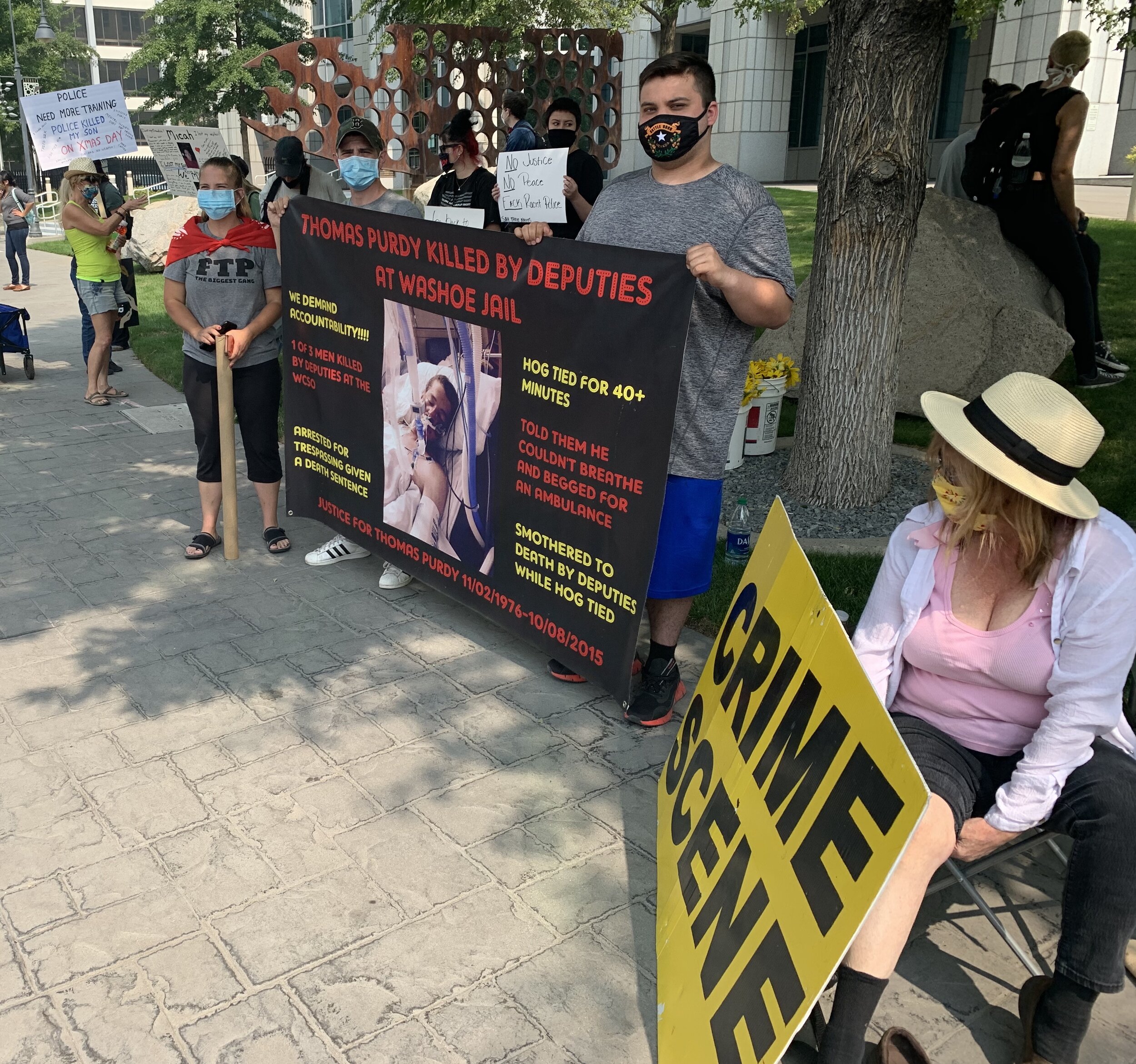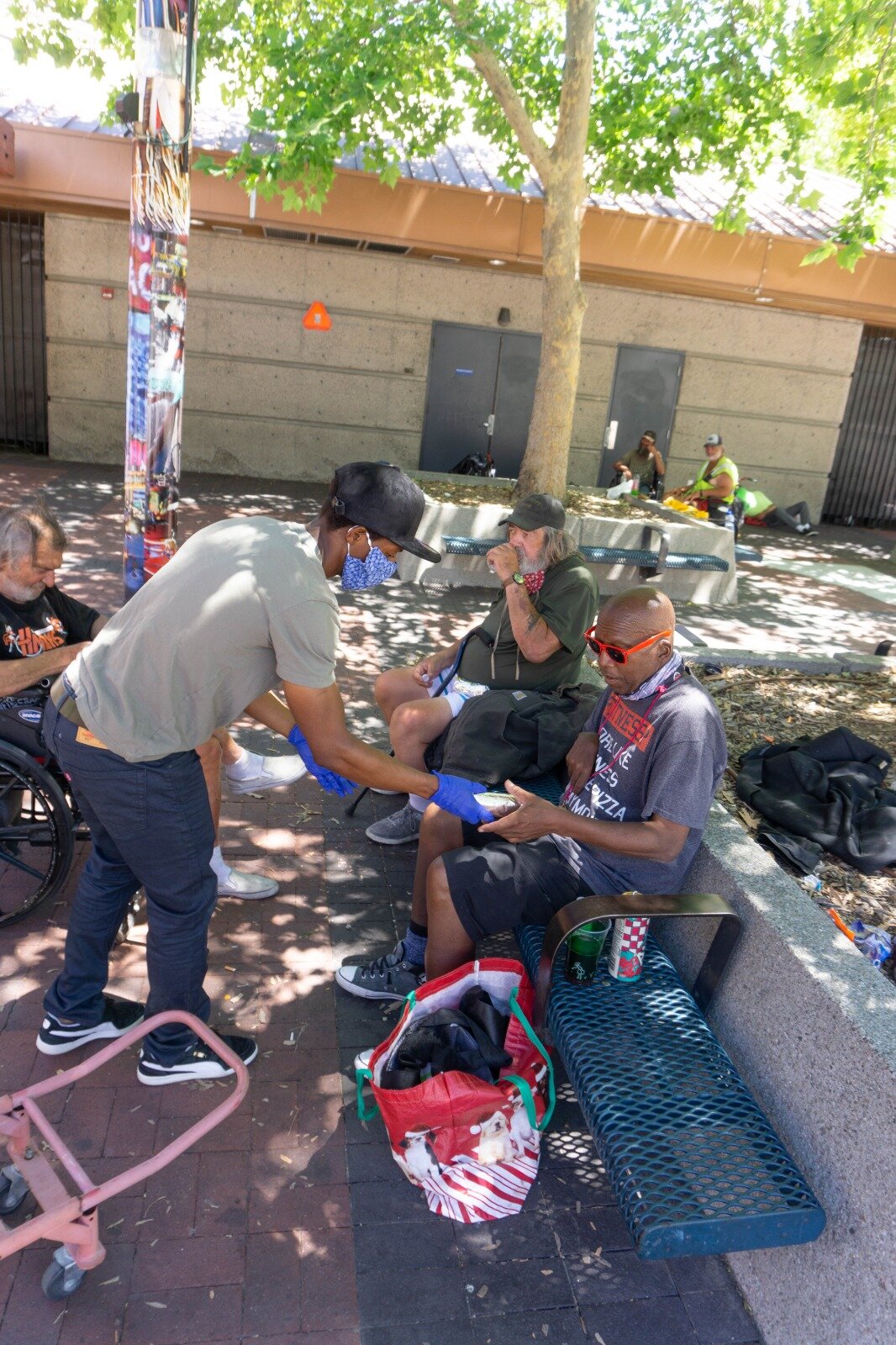Large Settlements but No Justice
Like on her Facebook Page, Annemarie Grant keeps the focus on her late brother Thomas Purdy, who died October 8th, 2015, after being hog tied while in custody of the Washoe County Jail. “I fight daily for his justice!” she writes.
“I just share his story as much as I can across social media and to the general public. If I see somebody, you know, I tell them what happened. Everybody I meet, I tell them what happened with my brother ,” she told us in a recent phone interview as she took a break from her work in her home outside Boston.
Following his arrest for alleged trespassing at the Peppermill casino five years ago, Purdy kept telling Sherriff’s deputies at the Washoe County Jail he couldn’t breathe as he tried to fight off restraints, with his hands tied against his back and attached with straps to his ankles. He asked a jail intake nurse to send him to the hospital, telling her: “I can’t breathe, ma’am.”
An investigation by Sparks PD found no crime involved, the medical examiner ruled Purdy’s death a homicide by "complications of excited delirium," and when contacted the sheriff’s office had no comment on whether any deputies involved faced disciplinary action.
Purdy’s father got a $25,000 settlement from the city of Reno, a $50,000 settlement from the Peppermill and received a $100,000 settlement from Washoe County over wrongful death lawsuits.
“Filing a lawsuit is the only type of justice that you've got open,” Grant said.
Grant is grateful for Reno Cop Watch organizing yearly events to support families of those killed by local law enforcement.
“They were the first to reach out to me,” she told us. “I feel like they get some hate from police supporters, but they are about transparency and accountability, nothing else. Also obviously they promote filming the police, which everybody should be doing. It is a way to protect other people. We all know how hard it is to get the body cam footage released. I view them as a vital resource for the community to be aware of what's going on. “
Suddenly More Attention
Purdy’s death started getting more attention after other inmates died while in custody, and local media started investigations.
Two months before Purdy’s killing, it was revealed, Niko Smith died in similar circumstances at the Washoe County Jail, which later resulted in a $75,000 settlement. In August 2016, Justin Thompson died after he struggled with deputies at the jail, and a hood was put over his head. His family got $500,000 settlement and a gruesome video was released.
“Knowing what my family experienced from law enforcement, when my brother was killed, I feel it's important to speak out and let people know not to get swept under the rug, because people forget,” Grant said of why she’s taken a leading role in the yearly protest to support the families of those killed by local police, as she did this past September.
“I don't want anybody ever to forget what happened to my brother and the two other men up at the jail, as well as the families who have lost people in officer involved shootings. They experienced the same exact type of lack of accountability and transparency. When their loved one is killed, you get a wall of silence from the police.”
She says local media coverage or official investigations which find no criminal wrongdoing from law enforcement add to the hurt. “They criminalize the victim. I believe it is to sway the court of public opinion.” She says sometimes support from families in similar situations is the only support a family member gets.
“There’s a lot of negative stigma that comes along with being a family member of somebody who was killed by police. So I feel like we need to bounce off of each other and use the strengths of each other because it's not easy to get up and for us to share your loved one's story. Because of the stigma that comes along with it, and because things need to change, I don't want to see more people dying. Someone has to be loud. Someone has to keep speaking out or it will just fade away and get swept under the rug because people forget and I can't let them forget what's happening.”
A screengrab of an image search for Thomas Purdy and Reno.
The Need for Change
In our interview, Grant repeatedly refered to the 1989 Graham v. Connor Supreme Court decision which established that police actions must be judged by what a so-called ”reasonable” officer might do under similar circumstances. This according to legal analysts gives police wide and ongoing latitude for their actions, whatever they may be, even deadly ones without seemingly any need. Grant would like to see that decision overturned, or else she says police “will continue to legally be able to get away with killing people.”
Even more attention has been brought to police conduct in the wake of George Floyd’s killing which sparked the current cycle of global protests.
“I think it's long overdue,” Grant said of this heightened interest. “It’s given families some hope that there are people who are now aware and they don't want this stuff to continue. They see the budgets that's at the police. I believe it's 39% of the 2021 budget is going to Reno police department [according to documents released by Reno Cop Watch]. It gives me hope that with enough backing and pressure on elected officials and the police department and the Sheriff's office, that things can change.”
Where does she get her strength we asked her?
“My strength comes from the families,” she said of the positive power social media and other activists can have in establishing new connections. “I wasn't connected with other families, until about a year and a half, maybe two years after my brother was killed. I get my strength from them. And, the way that I remember my brother is by spreading the names of other people every day on my Facebook, sharing the names of everybody that was killed during interactions in the United States, at least on that particular day,” she said.
What about all the negative comments which are seen on social media targeted at those who criticize police?
“I think it's easy to judge from an imaginary pedestal where you believe that you are safe and only criminals are killed by police, but that isn't the reality of it,” she said. “I realized that ignorance is bliss sometimes, and it's easier thinking, ‘these days, things, bad things only happen to bad people. ‘ But that's not the truth.”
















![“[Reno Land’s vision] was to develop half of the property with some infill, meaning they would bring in some 150 apartments on the western portion of the property. Then on the other half, they would revitalize the club knowing that it was an iconic …](https://images.squarespace-cdn.com/content/v1/5675d221cbced60a236e28b8/1600271606075-J2831VXZK9IR0945VXA4/Lakeridge+%288%29.JPG)
![“Members were actually still paying dues late into April, when [Reno Land] put their site plan out and they were talking about how, ‘As a result of COVID, the club is no longer financially viable,’ but the billing cycle for the club wasn’t complete …](https://images.squarespace-cdn.com/content/v1/5675d221cbced60a236e28b8/1600283791762-5TRVV09WY5T80YK3JLEO/Screen+Shot+2020-09-16+at+12.16.09+PM.png)












![The Reno Initiative for Shelter and Equality [RISE], in conjunction with Washoe County, recently launched Our Place for women, families and seniors, with a different, more relaxing vibe than other shelters in Reno.](https://images.squarespace-cdn.com/content/v1/5675d221cbced60a236e28b8/1598908921055-X2Y1BYRTIKPHJE5HN23N/OurPlace+%285%29.JPG)



![“I've met with a lot of the women there who have their pets and it has made a world of difference for them. [Having pets] also bonds the guests together, they are a morale booster and so it's been going very well. A lot of people who didn't take she…](https://images.squarespace-cdn.com/content/v1/5675d221cbced60a236e28b8/1598911407869-P2JDMX36H37H7Q80JLA3/OurPlace+%2813%29.JPG)































